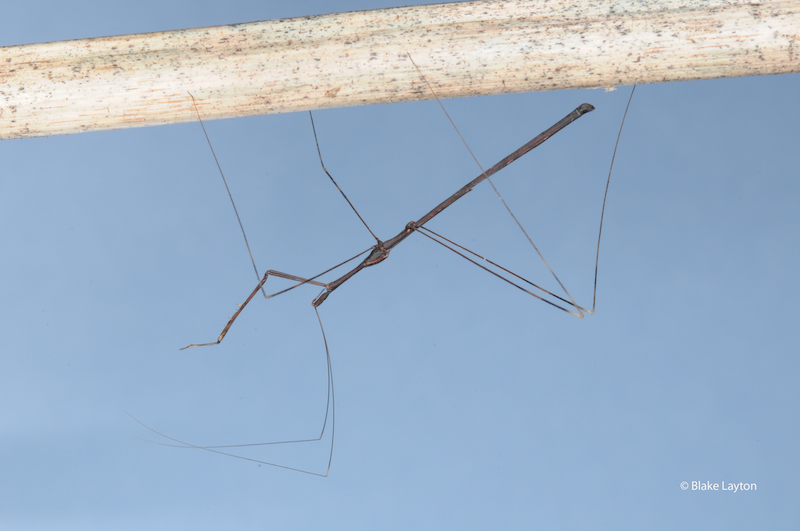Thread-legged Assassin Bug, Vol. 8, No. 10
Emesaya brevipennis
Order: Hemiptera
Family: Reduviidae
This is one skinny bug! Adults are about 1 ¼ to 1 ½ inches long, but their bodies are uncommonly slender, and they have those long, thin antennae and long, thread-like legs.
Look closely and you will see the front pair of legs is raptorial, or adapted for capturing prey, like a praying mantis. Look even closer and you will see they have a long, slender beak, with piercing-sucking mouthparts.
Thread-legged assassin bugs are in the family Reduviidae, which is a large group of true bugs that prey on other insects. Many assassin bugs hunt by day, but thread-legged assassin bugs are largely nocturnal and are attracted to lights. I don’t see these very often, and when I do, they are often on a building, near some exterior lights, or they are caught in a spider web. On relatively rare occasions I have found them in more natural settings, but these slender, camouflaged bugs are hard to spot.
The biology of these insects is not well-known, but the literature indicates they complete a couple of generations per year, with the nymphs also being predators. Adults prey on a variety of small insects and are said to frequent spider webs, where they steal prey from the web or prey on the small spiders themselves. Like most assassin bugs, they can bite, but few people have experienced this.
Adults also have little, short wings; in fact, the “brevipennis” part of their name means “short wing. The wings are so short that they don’t look like they could provide enough lift for flight, but these are not heavy insects. They look strange in flight, almost surreal, and they can’t fly upwind very well, but they do fly readily.
There is another group of true bugs that look a lot like thread-legged bugs, having long, thin antennae, and long, thread-like legs. These are called “stilt bugs” and belong to an entirely different family, Berytidae. But this resemblance is superficial and close examination will reveal several distinguishing differences. The front legs of stilt bugs are not raptorial; their antennae usually end in a swelling or knob, and adults have wings that are the length of their abdomen. Stilt bugs are primarily plant feeders and are sometimes seen in relatively large numbers on suitable hosts.
See archived issues of Bug’s Eye View for articles on other, more robust-bodied, assassin bugs, such as Zelus assassin bug and the Eastern bloodsucking conenose.
Blake Layton, Extension Entomology Specialist, Mississippi State University Extension Service.
The information given here is for educational purposes only. Always read and follow current label directions. Specific commercial products are mentioned as examples only and reference to specific products or trade names is made with the understanding that no discrimination is intended to other products that may also be suitable and appropriately labeled.
Mississippi State University is an equal opportunity institution.
Bug’s Eye View is now on Facebook. Join the Bug's Eye View Facebook group here.


